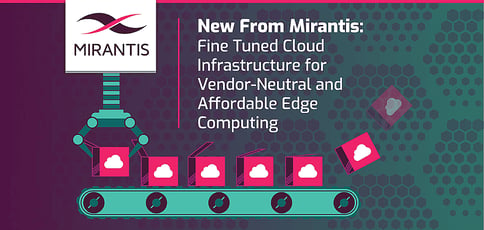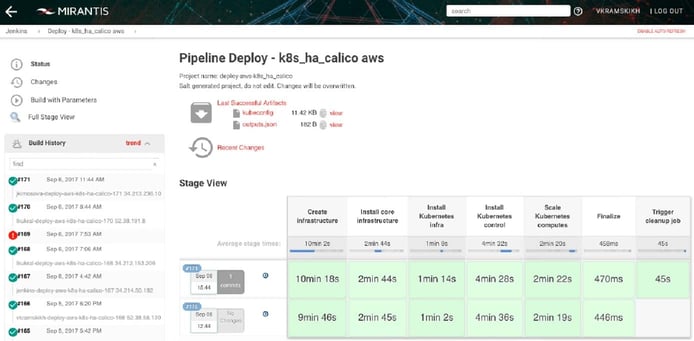
TL; DR: Leveraging open-source technologies and a tech-savvy DevOps approach, the managed open cloud experts at Mirantis are extending the organization’s infrastructure and applications to meet the challenging requirements of edge computing. The new service, MCP Edge, aims to serve telecommunications organizations and service providers looking to move from virtual machines to a more containerized, cloud-native architecture. The company’s cloud experts help build, deploy, and support the highly tuned version of Mirantis Cloud Platform in a way that promotes seamless and centralized lifecycle management, interchangeable hardware, and lower costs.
To maintain its leadership as the largest service provider in the Middle East and North Africa, Saudi Arabia Telecom made the rapid expansion into public and managed cloud services a core component of the company’s growth strategy — and they didn’t want to start small, either.
To be successful, according to Vice President of Cloud Services Saleh Mosaibah, the company needed to meet or exceed the cloud offerings of the global powers poised to enter the region: Amazon, Google, and Microsoft. That meant carrier-grade availability, performance, scalability, and security — while maintaining the ability to offer flexible services and an attractive pricing structure.
“To build a highly scalable cloud with competitive pricing, we needed an open ecosystem of technologies, not proprietary vendors. We saw others go that route and fail,” Saleh said online. Saudi Arabia Telecom chose OpenStack for its platform and enlisted the help of Mirantis, cloud hosting experts and a leader in the open-source project.
“Mirantis has the most OpenStack expertise in the market and open integrations to a vast number of software and hardware vendors,” he said. “This gives us the freedom to choose the servers, storage, and other components that work best for us.”
With engineering support from Mirantis, Saudi Arabia Telecom now runs its cloud platform deployment across three datacenters and soon to be thousands of servers. Customer demand is higher than expected, but the company can comfortably scale to meet those needs with continued innovation from Mirantis.
“Mirantis is a great partner within the community, as it is well-positioned to see all community contributions and identify the ones to best meet our needs,” Saleh said. “Mirantis is driving features into the community that are important to Saudi Arabia Telecom.”
MCP Edge: Smaller Footprints and a Responsive, Horizontal Platform
Mirantis recently extended its OpenStack and Kubernetes expertise to introduce more edge computing support and functionality to its signature Mirantis Cloud Platform. Boasting smaller footprints and a horizontally oriented scaling solution, MCP Edge launched in late 2018 to enable service providers and telecommunications organizations, like Saudi Arabia Telecom, to run a variety of edge computing applications and move toward a containerized cloud-native architecture.

Mirantis Cloud Platform now includes an edge computing service, according to David Van Everen.
Mirantis engineers chose Kubernetes as the platform’s primary foundation, given the container-orchestration system’s smaller control-plane footprint compared to OpenStack. With the low-profile system for network configuration, routing, and management, Kubernetes offers a nimble way to operate applications at the edge.
To accomplish this, Mirantis relies on an in-house software project called Virtlet, which enables administrators to run virtual machines on Kubernetes clusters as first-class citizens. The project, which is completely open-sourced, combines the strength of operating VMs in Kubernetes with the software-defined networking capabilities of OpenStack, according to David Van Everen, SVP, WW Field Organization.
“You can orchestrate them the same way as containers,” he said.
Working With Clients to Architect, Deploy, and Support New Solutions
Mirantis brings the same knowledgeable, customer-focused approach to delivering MCP Edge as it does with the company’s full cloud platform, David said. The build-operate-transfer method ensures solutions are perfectly created to meet each client’s specific needs.
“We would work with them initially to architect the solution,” he said. “For instance, there could be a combination of OpenStack-based edge clouds along with Kubernetes-based edge clouds depending on size requirements and the workloads running on them.”

In addition to its headquarters in Campbell, California, Mirantis has offices in Texas, Utah, Russia, Europe, and Japan.
Starting with the proof of concept or viability of MCP Edge, Mirantis helps customers assess, justify, architect, and demonstrate business value outcomes of deploying the company’s cloud and edge computing platforms. According to David, this all comes back to the build-operate-transfer delivery approach Mirantis takes.
“The Operate phase is essentially managed services, where Mirantis is actively operating our customers’ clouds on their behalf,” David said. “The Transfer phase, where the customer takes on operations, is optional, and roughly half of our customers never elect to transfer operational control to themselves. For those customers that do complete the Transfer phase, they rely on Mirantis for enterprise support. I believe that all of our service provider customers are operating their clouds themselves, and we’re providing them enterprise support.”
Bringing DevOps to Independent, Centralized Lifecycle Management
One of the biggest differentiators for Mirantis and MCP Edge, according to David, is the ability to independently manage the lifecycle of all the open-source services that contribute to the cloud platform.
“Rather than using a monolithic distribution for OpenStack, we instead break OpenStack into the individual services, including Nova for provisioning, Neutron for Networking-as-a-Service, Cinder for block storage, and others,” he said. “We can lifecycle manage those through a DevOps toolchain based on git, Gerrit, Jenkins, and a few other things for managing the configuration.”

StackLight and DriveTrain help teams monitor and manage the lifecycles of various cloud computing services.
Mirantis DriveTrain enables organizations to treat cloud infrastructure just like applications or code. Policy-driven automation simplifies the management of the complex cloud systems, along with streamlining various recurring duties and workflows. Organizations can continuously tune and tinker with various configurations to adapt to changing business needs while delivering important updates with minimal interruption.
“Anytime you need to change or update the Cinder service to the latest version to fix a nasty defect or something, you can simply make that individual change to the reclass model, run it through a Gerrit code review, run a Jenkins pipeline to update the services across the environment, and you’ve essentially managed the code for your entire infrastructure,” David said. “The same thing is applied to edge computing now. We can have hundreds of clouds distributed across a large region or multi-region, and all of that can be lifecycle managed from one centralized point.”
David said the organization is working to deploy the same advantages as part of the company’s operations support system, StackLight, to provide centralized logging, monitoring, and alerting vizualizations in a single user interface.
Mirantis Concentrates on Providing Flexibility and Lower Costs
Across the product portfolio, the Mirantis commitment to using and contributing to open-source technologies feeds into what David identifies as the company’s two biggest advantages or differentiators: affordability and adaptability.
“We’re providing enterprise-grade support, but other than that, all of the software is actually based on open-source and upstream projects,” he said, adding that while Mirantis adds a little hardening to Kubernetes and OpenStack, all changes to the projects’ source code are contributed back to the communities.
Using open-source software means organizations aren’t locked into using a specific vendor’s hardware or software configurations — ultimately saving customers money.
“I think service providers in particular are looking for ways to streamline their cost structure for edge-based solutions and applications they’re providing to consumers and businesses,” David said. “Having that lower-cost model is important. As people get creative about how to use edge computing to provide amazing new experiences for customers, they’re going to need a flexible platform that can be adapted to those specific use cases and tailored to the constraints of those applications.”
HostingAdvice.com is a free online resource that offers valuable content and comparison services to users. To keep this resource 100% free, we receive compensation from many of the offers listed on the site. Along with key review factors, this compensation may impact how and where products appear across the site (including, for example, the order in which they appear). HostingAdvice.com does not include the entire universe of available offers. Editorial opinions expressed on the site are strictly our own and are not provided, endorsed, or approved by advertisers.
Our site is committed to publishing independent, accurate content guided by strict editorial guidelines. Before articles and reviews are published on our site, they undergo a thorough review process performed by a team of independent editors and subject-matter experts to ensure the content’s accuracy, timeliness, and impartiality. Our editorial team is separate and independent of our site’s advertisers, and the opinions they express on our site are their own. To read more about our team members and their editorial backgrounds, please visit our site’s About page.

